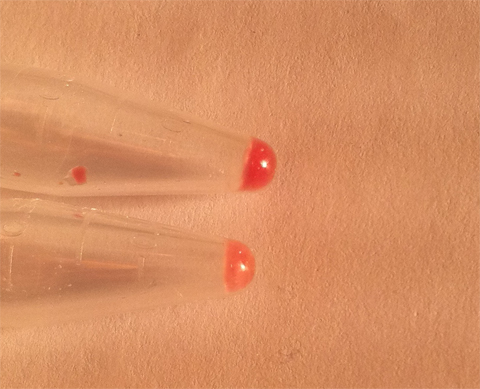|
Introduction
Halobactera has a membrane protein called bacteriorhodopsin which acts as a proton pump, converting light energy into chemical energy that the cell can use. It is purplish in color, and when the cell is producing large quantities of this protein, it is clearly purple. The production of Bacteriorhodopsin is regulated by the Bat gene, whose expression is dependent upon the amount of oxygen and light that the cell receives. In this lab, we wanted to alter the amount of light that the cells received in order to observe possible differences in cell phenotype and cell growth. We repeated this experiment several times in an attempt to get more distinct differences between the phenotypes of cells grown in high light and no light.
Procedure
- Add 15 mL of Complete Media to each of the 50mL flasks.
- Add 3 mL of Halobacterium with an OD of about 1.2 to each flask.
- Add a stir stick to each flask.
- Cover the top of each flask with a piece of aluminum foil (later trials used black electric tape).
- Label the flasks as following:
Light – 1 |
Dark – 1 |
Light – 2 |
Dark – 2 |
Light – 3 |
Dark – 3 |
Light – 4 |
Dark – 4 |
Also label each flask with the date, “Halo NRC-1”, and your initials
- Cover each flask labeled “dark” completely with aluminum foil so that light cannot enter.
- Position the spinning plates so that they are directly in the light from the lamp.
- Making sure to record the time you start spinning, turn on the plates to spin at level 1.
- At around the same time every day after the experiment begins, take 1.6 mL from each flask and place into a centrifuge tube.
- Spin down into a pellet by placing the tubes in the centrifuge and spinning for about a minute.
Setup
Results
 (High light on top, Dark on bottom)
(High light on top, Dark on bottom)
Conclusion
While we did not get entirely purple and tan pellets as we hoped based on the difference in bacteriorhodopsin, this experiment still showed the effect of an environmental change. We were able to see a significant difference in the color of the pellet taken from a sample grown in the light and one grown in the dark. We also learned that a cell pellet will bleach to white if left out after around a week or so meaning that only data taken just after the end of the experiment is valid. Additionally, using a cardboard reflector mechanism made out of foil and cardboard did not alter our results and changing the distance the flasks were from the light had very minimal effect as well.
|



